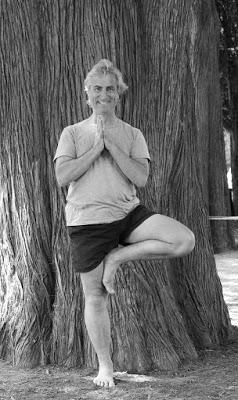
Richard Rosen by Melina Meza
Back in India in my younger days, I often visited my grandfather who owned a house that was bereft of the usual furniture. The walls and floors of the house were made from cattle manure (dried cow poop), sand, and mud paste, and was a permanent structure. Such mud houses in the village were re-mudded every week. It was a common practice back then to walk barefoot, sit on the ground and sleep on the mudded floor. Meals were served on banana leaves and people (hosts and visitors) sat on the floor cross legged and ate the food with their fingers. Life was simple devoid of plates, soaps, cleaners, detergents, etc. While young kids and adults slept on the floor using a rice bag as a pillow, older people slept on a jute mat. This was not unusual and restricted to my grandfather’s home; this was a common practice across all homes. Indeed, my grandfather used to perform his morning duties (mantras + meditation + asanas) on the bare floor. There were no mats or props. I learnt yoga asanas the hard way. In fact, notice that in the black and white pictures of T. Krishnamacharya and his students, asanas were performed on the dusty streets or on the bare floor. In all these cases, one fact stood out clearly: people were grounded or earthed. Grounding or earthing refers to connecting directly with the earth. It refers to direct skin contact with the surface of the earth, such as with bare feet or hands, or with various grounding systems. This means that any part of the body at given time needs to touch soil, sand, water, or a conductive surface that is in contact with the earth. In today’s world most of us have lost this contact with the earth even when we are outside. Some experts believe that this disconnect is a contributor to the many rising health problems we face today. A growing body of research is finding numerous health benefits as a result of the physical body being grounded. Reports indicate that walking barefoot on the earth or sustained contact with the earth enhances health and provides feelings of well-being. You may wonder how this happens. During the normal process of metabolism, the body generates reactive oxygen species, which are also referred to as free radicals. While these compounds have the ability to attack and destroy foreign elements within the body, including bacteria and viruses, excess free radicals are detrimental to health and have been implicated in chronic disease and accelerated aging. Excess free radicals trigger chronic inflammation, chronic pain, atrophy of muscles and joints, and chronic diseases, including heart disease and type 2 diabetes, and neurodegeneration. In short, while it is good to have free radicals, the excess needs to be removed from the body. One way to quell them is to consume plant foods that possess components that can neutralize the free radicals. Additionally, the safest and best way to neutralize the free radicals is getting grounded or earthed. If the body has excess free radicals, direct contact with the earth facilitates the absorption and neutralization of the free radicals thus limiting their damage to the body systems. The most immediately noticeable effect people report from being grounded is that they “feel better.” This has been described as a feeling of greater peace within themselves and of feeling calmer with reduced stress levels. If there is pain present then often this is reduced or disappears completely. With regular grounding, numerous health benefits have been reported, such as improved immune function, improved digestion, improved sleep, rapid healing of injuries, improved blood circulation, stabilization of the body's basic biological rhythms, reduction in inflammation, chronic pain, and reduced stress/anxiety/irritability. While these may be anecdotal reports, there are a few evidence-based research findings that indicate that being grounded helps in reducing pain and inflammation. In a small pilot study of 12 subjects The biologic effects of grounding the human body during sleep as measured by cortisol levels and subjective reporting of sleep, pain, and stress grounding the human body during sleep reduced night-time levels of cortisol and resynchronized and aligned the cortisol hormone secretion with the natural 24-hour circadian rhythm profile. Furthermore subjects reported that grounding the human body improved sleep and reduced pain and stress. In The effects of grounding (earthing) on inflammation, the immune response, wound healing, and prevention and treatment of chronic inflammatory and autoimmune diseases grounding reduced or even prevented in some cases the cardinal signs of inflammation following injury: redness, heat, swelling, pain, and loss of function. Rapid resolution of painful chronic inflammation was confirmed in 20 case studies using medical infrared imaging. The results from several pilot studies have been so astounding that researchers are encouraging to take advantage of the virtually limitless source of mobile electrons the earth provides when we are in direct contact with it. The earth may in fact be the best antioxidant, with zero negative secondary effects, because our body evolved to use them.Obviously, walking outside barefoot is the easiest and cheapest way to ground yourself and practice earthing. But how about yoga sessions on the beach? No need for artificial lighting, mats, or room heaters as the sun provides the natural heat and light and this is possibly the best place with both the sand and saltwater being extremely conductive. Perhaps this is why many people seem more relaxed and happier after a vacation at the beach! Of course you can also practice yoga out in the woods or in a park on the grass—just lose the mat.Subscribe to Yoga for Healthy Aging by Email ° Follow Yoga for Healthy Aging on Facebook and Twitter ° To order Yoga for Healthy Aging: A Guide to Lifelong Well-Being, go to Amazon, Shambhala, Indie Bound or your local bookstore.
